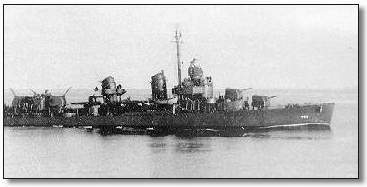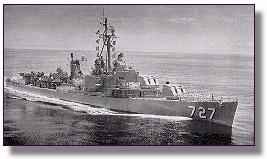|
The DeHaven in World War IIThe First DeHavenDD-469: dp. 2050; l. 376'6"; b. 39'8"; dr. 17'9"; s. 35k.; cpl. 273; a. 5 5", 10 21" tt., 6 dcp., 2 dct.; cl. DeHaven (DD-469) was launched 28 June 1942 by Bath Iron Works Corp., bath, Maine; sponsored by Miss H. N. DeHaven, granddaughter of Lieutenant DeHaven; and commissioned 21 September 1942, Commander C. E. Tolman in command.
On 1 February 1943, DeHaven screened six LCT's and a seaplane tender establishing a beachhead at Marovo on Guadalcanal. While escorting two of the landing craft back to their base in the afternoon,DeHaven was warned of an impending air attack. She sighted nine unidentified planes and opened fire as six swung sharply toward her. She splashed three of these planes, but not before all six had dropped their bombs. DeHaven was hit by three bombs and further damaged by a near miss. One bomb hit the superstructure squarely, killing the commanding officer at once. All way was lost after the first hit and the ship began to settle rapidly, sinking about 2 miles east of Savo Island. One of the LTD's she had escorted rescued the survivors. She lost 167 killed and 38 wounded. DeHaven received one battle star for World War II service. The Second DeHavenDD-727: dp. 2,200; l. 376'; b. 41'1"; dr 15'8"; s. 34k; cpl. 336; a 6'5", 10 21" tt, 6 dcp., 2 dct; cl. Allen M. Sumner class The second DeHaven was launched 9 January 1944 by Bath Iron Works Corp., Bath, Main: sponsored by Miss H. N. DeHaven, sponsor of the first DeHaven; and commissioned 31 March 1944, Commander J. B. Dimmick in command.
On 10 February 1945, DeHaven sortied from Ulithi with TF 58, to prepare for the invasion of Iwo Jima, striking the Japanese mainland as well as the Nansei Shoto, and the providing fire support for the invading troops. Returning to Ulithi, 4 March, she sailed 10 days later to screen air strikes on Kyushu Japan, prior to the invasion of Okinawa. Until 13 June she screened the carriers and gave fire support at Okinawa. On 1 July she sailed from Leyte with TF 38 for the final air strikes and bombardments on the Japanese homeland which continued until the end of the war. Present on Tokyo Bay 2 September for the signing of the surrender, DeHaven sailed on 20 September for the States, arriving at San Francisco 15 October. Between 1 February 1946 and 3 February 1947, DeHaven served in the Western Pacific, joining the 7th Fleet in operation off the coast of China, and patrolling off the Japanese coast. She operated along the west coast through 1948, and 1949 and on 1 May 1950 cleared San Diego for another tour of duty in the western Pacific, arriving at Yokosuka the last day of May. De Haven received five battle stars for World War II service. Source: Dictionary of American Warships
|
 DeHaven sailed from Norfolk and reached Tonga-tabu,
Tonga Islands, 28 November 1942 to escort a convoy of troopships to
Guadalcanal to relieve the Marines who had been there since the invasion
landings in August. DeHaven screened the transports off
Guadalcanal from 7 to 17 December, then sailed out of Espiritu Santo and
Noumea in the continuing Solomon Island operations. She patrolled in the
water of the Southern Solomons to stop the "Tokyo Express," the
nightly effort to supply the beleaguered Japanese troops still fighting on
the invaded islands, and took part in two bombardments of Kolombangara
Island during January 1943.
DeHaven sailed from Norfolk and reached Tonga-tabu,
Tonga Islands, 28 November 1942 to escort a convoy of troopships to
Guadalcanal to relieve the Marines who had been there since the invasion
landings in August. DeHaven screened the transports off
Guadalcanal from 7 to 17 December, then sailed out of Espiritu Santo and
Noumea in the continuing Solomon Island operations. She patrolled in the
water of the Southern Solomons to stop the "Tokyo Express," the
nightly effort to supply the beleaguered Japanese troops still fighting on
the invaded islands, and took part in two bombardments of Kolombangara
Island during January 1943. DeHaven
escorted Ranger (CV-4) from Norfolk to Pearly Harbor, arriving 3 August
1944. She screened a convoy to Eniwetok between 16 and 30 August, and
returned to Eniwetok 5 October. a week later she got underway for Ulithi
to join TF 38. Operating from this base she screened the fast carriers
striking Luzon in support of the invasion of Leyte during November and
December. In coordination with the invasion of Lingayen Gulf, Luzon, the
force hit Formosa, Luzon, Camranh Bay, Hong Kong, Hainan, and Okinawa in a
score of strikes extending from 30 December 1944 to 26 January 1945.
DeHaven
escorted Ranger (CV-4) from Norfolk to Pearly Harbor, arriving 3 August
1944. She screened a convoy to Eniwetok between 16 and 30 August, and
returned to Eniwetok 5 October. a week later she got underway for Ulithi
to join TF 38. Operating from this base she screened the fast carriers
striking Luzon in support of the invasion of Leyte during November and
December. In coordination with the invasion of Lingayen Gulf, Luzon, the
force hit Formosa, Luzon, Camranh Bay, Hong Kong, Hainan, and Okinawa in a
score of strikes extending from 30 December 1944 to 26 January 1945.